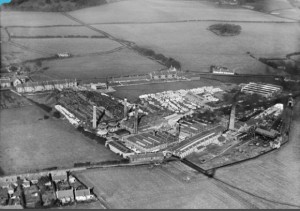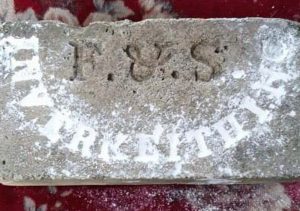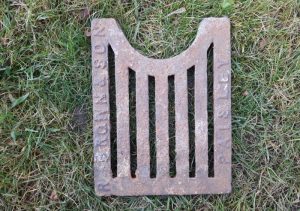John Howie (12/03/1833 – 20/09/1895) first started making firebricks in 1857 at Old Hurlford just west of the Defiance Coal Pit, where extensive bings of fireclay and blaes had been dumped from the coal workings.
John’s father was a coalmaster and initially many of the bricks were used to support the underground haulage roads. John soon sank his own shaft to the fireclay seams to obtain better and more uniform fireclay to supply the local ironworks. His younger brother, Robert, joined him in the business in 1867, thus establishing the company name which flourished for a century. Sadly Robert was only in business four years as he died in 1871, but John continued as a sole partner until his own death in September 1895. His eldest son, William Frank Charles took over, and with his brothers, Robert and Henry, the business flourished.
Under the active direction of John Howie senior, the Hurlford works expanded greatly and covered five acres by the time of his death. Production was further increased by the purchase of the nearby Plann Brick and Tile Works in 1886. This works had only started a few years before and was sited at Crosshouse Station on Plann Colliery No 8 Pit.
The production of firebricks developed into gas retort brick, plain and ornamental chimney cans, field drains and glazed sewage pipes from 2 to 24-inch diameter. Drinking troughs were specially designed for sheep, pigs, cattle and horses. Glasgow was growing fast and provided a huge market for white glazed sanitary ware so a depot and showroom were maintained at 47 Cook Street and managed by William Smith of Robson & Co. It was the age of international exhibitions and the company exhibited at Edinburgh in 1886 and at Glasgow in 1888. Among the items shown were crocks for butter and other kitchen supplies and a patent water filter formed by a porous earthen vessel through which water percolated through a bed of charcoal and as an extra precaution a layer of spongy iron was added to help clean out and to lessen the load on the charcoal filter. Garden seats and vases and even a ceramic umbrella stand catered for most requirements. The display led to orders for patented traps for Queen Victoria’s new home at Balmoral.
The business flourished but the risks as an unlimited company led to the incorporation in 1903, with a capital of £80, 000. Mary and Maggie Howie, unmarried sisters, became directors but retired five years later. In 1931 in the depth of the depression, the Company had sufficient reserves to make a scrip issue of £60, 000 £1 preference shares and to issue £60, 000 debenture loan stock to provide potential death duties.
In 1949, William Howie retired after 54 years as managing director, surely a span unequalled in any other fireclay company. Following his death, William Baird & Co Ltd bought over the company and set about rebuilding the Plann Works, which had been badly damaged by fire during the war years. About 135 men and women were employed at the Plann Works and a similar number at Hurlford. Further mergers led to Howie joining Shanks of Barrhead and the formation of Howie Southhook Ltd. In 1969 Shanks joined the Armitage Shanks Group which in turn was bought by the Blue Circle Cement Group in 1981. Production ceased at Plann and Hurlford in the mid-1970s and the works were demolished in 1978.
J & R Howie Ltd was put into voluntary liquidation in 1983 so ending a long-standing and famous name in the Scottish fireclay industry.
John Howie – Thomas Wyllie Howie, JP (8 April 1856 – 18 July 1927) was a Scottish captain of industry. He and his wife settled in Falkirk where he became a partner in Campbell & Co Fireclay Works and coal mine, Roughcastle. He later became the owner of the business. Previous to settling in Falkirk the Howie family lived in Hurlford, where they owned the renowned Hurlford Fireclay Works (until it was bought by Armitage Shanks), which produced pottery, bricks, chimneys, garden ornaments and enamelled sanitary ware (lavatories, baths, urinals etc).
Canmore
Below – 05/07/1847 – Glasgow Herald – The fire brick and tile clay on the lands of Hurlford and Skerrington near Kilmarnock to be let.

17/11/1856 – North British Daily Mail – Fire brick, flooring tiles &c. The subscriber has regularly for sale, flooring tiles of excellent quality at 2s 3d per square yard. Fire bricks at 55s per 1000 and flue covers made to order, at 2s per cubic feet. All delivered free at Glasgow Station. John Howie. Hurlford Brickwork, Kilmarnock, 18/10/1856.
Below – 1857 – Hurlford Brickworks.

08/08/1857 – Paisley Herald – Highland Agricultural Society Show … We also observed some fine specimens of this class from Mr Howie’s Hurlford Fire Clay Works …
1858 – Mineral Statistics of the United Kingdom of Great Britain and Ireland for 1858 – Hurlford, clay of coal measures. Name of freeholder – John Howie. Manufacturer – John Howie & Co. Manufacture – Bricks, chimney cans, pipes and retorts &c.. Estimated 9,360 tons annually.
Below – 1858 – 1859 – Advertisement. John Robson, salesman for the Hurlford Fire Clay Works.

Below – 24/03/1858 – Glasgow Herald – Advertisements. To shippers, builders, agriculturists, gas managers &c. Hurlford Fire Clay Depot 47, Cook Street, Glasgow. John Robson, a salesman, begs respectfully to intimate to his friends and the public, that he has always on hand-glazed sewerage pipes, of various sizes, with connections which will stand severe pressure, if required, pressed and unpressed fire bricks, composition bricks, paving tiles, flue covers, gas retorts, oncomes, vent linings, plain and ornamental chimney cans, cattle troughs, horse mangers, large cisterns made to order, and ground fire clay of the finest quality. That the clay is of superior quality, has been shown by Professor Penny’s analysis, and the analysis is fully borne out by the practical working of the clay whenever it is required to stand severe heats; and the prizes awarded to goods from Hurlford Fire Clay Works at agricultural shows at Glasgow and Dumfries last year, prove that the workmanship is superior. All orders sent to the above address will be promptly executed. June 1858.
09/06/1858 – Glasgow Herald – Glasgow Agricultural Society’s Show.
Feeding troughs for pigs – 1st William Smith, Hurlford Fire Clay Works, Kilmarnock and James and Matthew Craig, Dean Fire Clay Works, Kilmarnock commended.
Feeding troughs for sheep – 1st William Smith, Hurlford Fire Clay Works, Kilmarnock.
Churn worked by hand – 1st James and Matthew Craig, Dean Fire Clay Works, Kilmarnock.
Traverse divisions – Rack and manger for farm stables – 1st William Smith, Hurlford Fire Clay Works, Kilmarnock.
Tile and pipes for field drainage – 1st William Smith, Hurlford Fire Clay Works, Kilmarnock.
Glazed socketed pipes for sewerage – 1st William Smith, Hurlford Fire Clay Works, Kilmarnock. James and Matthew Craig, Dean Fire Clay Works, Kilmarnock commended.
08/09/1858 – Aberdeen Press and Journal – Highland and Agricultural Society’s Exhibition.
Section LXXVIII – Tiles and pipes for field drainage. Premium £1. John Robson, 47 Cook Street, Glasgow and William Brodie, Seafield Tile Works, Dunbar – commended.
Section LXXIX – Glazed socketed pipes for sewerage. Premium £1. William Keith jun, Aberdeen and John Robson, Glasgow – commended.
Also commended – John Robson, Glasgow, compressed firebricks made by John Howie, Hurlford Fire Clay Works, Kilmarnock.
Below – 05/03/1859 – Farmers Gazette – Advertisement. John Robson, salesman for the Hurlford Fire Clay Works.

05/06/1859 – Glasgow Herald – Glasgow Agricultural Society Show – John Robson, Hurlford Fireclay Depot, 47 Cook Street, Glasgow – paving bricks for stables – commended. Flooring tiles for farmhouse kitchens and a variety of other articles made from fireclay – highly commended and a silver medal.
29/07/1859 – Montrose Standard – John Clark, plasterer, 5 Chapel Street, Forfar begs to announce that he has been appointed agent for the Hurlford Fire Clay Company and is prepared to supply on the most reasonable terms, chimney cans, glazed pipes, vent linings, cattle troughs, managers, vases &c. The above are of first-rate quality and are strongly recommended. Depot, North End of Castle Street, Forfar.
Below – 18/08/1859 – Londonderry Standard – George Ferguson and James Kirker agents.

17/11/1859 – Belfast Mercury – Hurlford Fire Clay Depot. 01/07/1859. James C. Kirker, corn broker and commission agent, respectfully begs to intimate that he has removed to No 40, York Street, corner of Frederick Street.
27/02/1860 – Glasgow Herald – Hurlford Fire Clay Depot, 47 Cook Street, Glasgow – John Robson, Salesman desires to tender his thanks to his customers for their liberal patronage bestowed and trusts that by punctual attention to business, to merit their further approbation. Notice – always on hand gas retorts, blast furnace blocks, fire bricks for home sale and exportation; flue covers, ground fire clay, plain and ornamental chimney cans. Glazed sewage pipes from 2″ to 24″ bore to stand severe pressure. Every description of fire clay ware manufactured. All orders sent to the above address will be promptly attended to. 02/02/1860.
Below – 1861 – Advert Hurlford Fireclay Works, Kilmarnock.
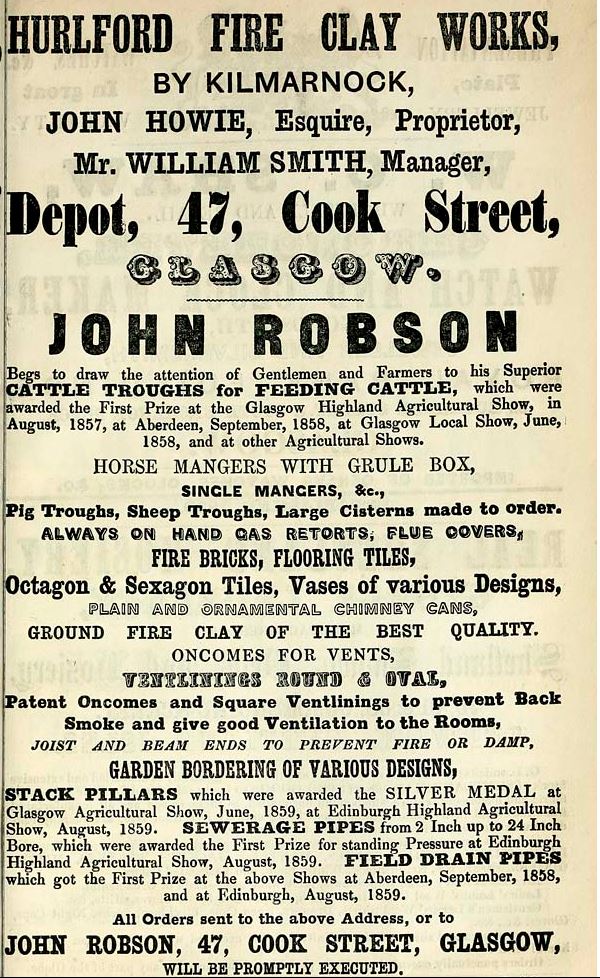
Below – 01/03/1861 – The Dublin Builder – Hurlford Fireclay Works advert. John Robson.

01/08/1861 – Edinburgh Evening Courant – Highland and Agricultural Society Show at Perth –
Pipe or Tile Machine for hand or power, eight sovereigns, George Finlayson, Gighty Burn, Arbroath …
Tiles or pipes for field drainage. Two sovereigns – Christie & Son, Shore Road, Stirling. 2d. Bronze medal – Alexander Meldrum, Seafield Tile Works, St Andrews.
Glazed socketed pipes for sewerage, three sovereigns John Robson 47 Cook Street, Glasgow, 2d Bronze medal, Robert Brown, Ferguslie Fire clay Works, Paisley. Commended Edmonstone Coal Co, Dalkeith.
Feeding troughs for byres, One sovereign John Robson 47 Cook Street, Glasgow, 2d Bronze medal, Robert Brown, Ferguslie Fire clay Works, Paisley.
Extra implements machines etc – Highly commended – Collection of vases, paving bricks, horse manger, pig trough and milk cooler – John Robson.
12/06/1862 – The Scotsman – John Robson, Glasgow exhibited a large and varied collection of useful and ornamental fireclay goods for which he was awarded a silver medal.
19/06/1862 – Stirling Observer – The International Exhibition, London … Mr John Howie, Hurlford Fire Clay Works, Ayrshire shows examples of clay tubing, shieldings for beam ends in the walls of buildings – a most useful contrivance to secure these parts dry and to prevent dry rot – arch bricks, cattle troughs and a number of other articles of use in the dwelling and farmyard; and also ornamental objects in the same material such as water fountains and flower vases, all tasteful in their general colour and sharp and distinct in their decorations. The objects when struck ring well, showing them to be sound and to have been well fired in making …
22/07/1862 – Caledonian Mercury – Jury Trials – before Lord Ormidale and a jury. Armour V Howie. This was a case set down for trial today. It is the action of Mr Armour of the Redston Fire Clay Works, Kilwinning against Mr Howie of the Hurlford Fire Clay Works, Kilmarnock to have the latter interdicted from using Mr Armour’s patented apparatus for measuring and regulating the supply of ground fire clay and water to the pugmill, in order to obtain through the mill a plastic clay of any consistency required in the manufacture of fire clay goods. An apparatus was some time since erected in by Mr Howie in his works at Hurlford which Mr Armour alleged to be in infringement of his patent. Mr Howie denied the allegations as to the infringement and defended the action brought against him by Mr Armour and accordingly the case was sent down for trial on an adjusted issue. On Thursday Mr Howie intimated through his agent that he would no longer maintain his defence and he has consented to a decree of interdict passing against him, and finding him liable in expenses.
Below – 01/10/1862 – The Dublin Builder – William Smith, manager, Hurlford Fire Clay Works. Deport Talbot Street, Dublin. David McCulloch, agent.

31/10/1862 – Dublin Daily Express – Glazed sewerage and field drain pipes, Hurlford fire clay works, Depot, 58 Talbot Street, Dublin (Near the Drogheda Railway Terminus). Manufacture all varieties of terra cotta articles, fire bricks, chimney cans, flue lining, roof ridge and flooring tiles, wall coping, rybats and corners, enamelled cattle troughs and horse mangers vases, fountains, &c. Glazed half faucet sewerage pipes so highly recommended. Ground fire-clay and roman cement. Prices Moderate.
24/12/1862 – Londonderry Standard – To builders &c. The subscriber is the sole agent for the Hurlford Fire Clay Company and keeps generally in stock a supply of their fire clay goods so celebrated for hardness, durability and cheapness consisting of cattle troughs and mangers, chimney cans and vases, sewerage pipes, flue linings, roofing tiles and all of various sizes. Contractors supplied at company wholesale prices. James Sherrard.
02/05/1863 – Ayrshire Express – Ayrshire Agricultural Association.

Below – 29/08/1863 – Farmer’s Gazette – Hurlford Fire Clay Works advert. Depot Talbot Street, Dublin.

09/06/1864 – Glasgow Morning Journal – Glasgow Agricultural Society show – Highly commended – John Robson, Glasgow – fire clay troughs, bricks etc.
Below – 16/06/1866 – Ardrossan and Saltcoats Herald – Hurlford Fire Clay Works advert. J & R Howie.

Below – 1867 – Advert John Howie, Hurlford Fire Clay Works, Kilmarnock.
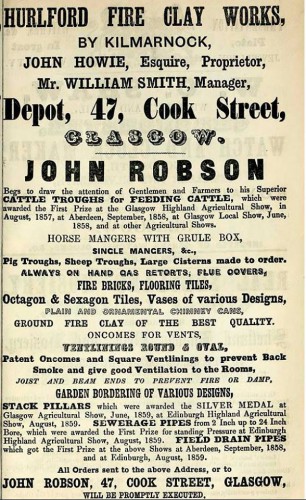
31/07/1867 – Glasgow Herald – Highland and Agricultural Society’s Glasgow Show – Messrs J & R Howie have also (stand 74) a capital display of fire clay articles showing the adaptability of the material to an immense variety of purposes. Of the heterogeneous list, we can only find space to mention cattle troughs, horse mangers, washing tubs, sundials, water cisterns, paving tiles, building bricks, garden edging and chimney cans.
01/08/1867 – Stirling Observer – Highland and Agricultural Society’s Show, Kings Park, Glasgow – Principal exhibitors … J & M Craig, Kilmarnock, fire clay works and … J & R Howie, Kilmarnock, fire clay work.
1868 – J & R Howie, Fire Clay Works, Hurlford.
1869 – Hurlfords Fire Clay Works. Depot 71 – 73 Dale Street, Tradeston. John Robson, Agente, Kilmarnock (agents for the Scottish Brick Enamelled Company) House – 51 Milton Crescent, Portobello. Telephone 82459 Portobello.
1869 – Hurlfords Fire Clay Works. Depot 71 – 73 Dale Street, Tradeston. John Robson, Agent.
04/06/1870 – Ardrossan and Saltcoats Herald – Master and servant case. At the Sheriff Court, on Friday week, Messrs J. & R. Howie, fire clay works, Hurlford, complained against James Gillespie, fire clay worker, Collier Row, Hurlford, that in violation of the Master and Servant Act of 1867, he had left his work without giving the proper warning of 14 days, according to the rules of the work. Claim was made of compensation to the amount of £10 sterling. He pled guilty and was fined in the modified penalty of £2, and £2, of modified expenses, to be paid in 14 days, or go to prison for 10 days.
03/08/1870 – North British Agriculturist – The Highland and Agricultural Society’s Show at Dumfries … J & R Howie, Kilmarnock, had a good display of cisterns, cattle-troughs, milk-coolers, pipes, vases, paving-tiles, paving-bricks, and wall-coping; also stack-pillars made of fire-clay.
Below – 29/04/1871 – Ardrossan and Saltcoats Herald – J & R Howie, Hurlford Fire Clay Works advert.

1872 – J & R Howie, fireclay manufacturers, Hurlford by Kilmk.
17/01/1872 – Glasgow Herald – Unground Fire Clay – For Sale by Public roup at noon on Thursday 1st, at Hurlford Fire Clay Works, Kilmarnock, a quantity of unground fire clay.
16/08/1872 – Glasgow Herald – 2000 yards of damaged pipes and chimney cans yet left for sale at Hurlford Fire Clay Works, Kilmarnock.
31/05/1873 – The Scotsman – Can makers (3 chimneys) wanted at Hurlford Fire Clay Works, Kilmarnock.
20/10/1874 – Glasgow Herald – Cisterns, cattle troughs, horse mangers, jaw boxes and pickling dishes, cheap and durable. Hurlford Fire Clay Works, Kilmarnock.
1878 – J & R Howie Hurlford Fire Clay. Goods Depot 6 Cook Street, Tradeston. John Robson Agent. Works Hurlford by Kilmarnock.
14/08/1880 – Glasgow Herald – Slightly damaged troughs, mangers, cisterns, pipes and chimney cans for sale. Cheap at Hurlford Fireclay Works, Kilmarnock.
09/09/1880 – Ayr Advertiser – Agricultural drain tiles for sale at Hurlford Fire Clay Works. Also, damaged milk coolers and chimney cans are cheap. J & R Howie.
02/12/1882 – Christchurch Times – Cattle, sheep and pig troughs and horse mangers, cisterns, scullery sinks, baths and washtubs of enamelled fire clay – white, yellow and brown enamel. All cheap and durable also Hurlford improved ventilating sanitary traps and patent chimney cans for curing blow down at FHurlford Fire Clay Works, Kilmarnock, Scotland.
Below – 13/01/1883 – Shields Daily News – Hurlford Fireclay Works, Kilmarnock.

Below – 13/08/1883 – Aberdeen Press and Journal – Buchan’s Patent infringements by Hurlford Fireclay Works and Caledonia Fireclay Works.

Below – 11/10/1884 – Dundee Courier – Stewart Robertson, Agent, Dundee.

20/05/1886 – Ayr Advertiser – Ayrshire exhibitors at the Edinburgh exhibition – on stand 859 Messrs J & R Howie, Hurlford Fire Clay Works exhibit some well-finished articles including white enamelled bath sinks, washtubs and milk cooler. Enamelled ventilating sanitary traps, horse mangers, cattle troughs, patent filters, enamelled bricks, sewer pipes, facing bricks, stable bricks and patent chimney cans for curing a blowdown. Among the outside exhibits the same firm show, three vases, a fancy fog house table of fireclay. Two fancy chairs for fog house of fire clay. Horse mangers, cattle troughs and sundial etc.
26/10/1886 – Edinburgh Evening News – International Exhibition – J & R Howie, Kilmarnock – Silver medal – a whole exhibit of fire clay goods. J & R Howie, Kilmarnock – Bronze medal – enamelware.
22/06/1887 – Greenock Telegraph – Why drink mud or microbes when Howie’s patent filter clears them out. Prices and reports from J & R Howie, Hurlford Fire Clay Works, Kilmarnock.
07/04/1888 – Glasgow Herald – Wanted at Hurlford Fire Clay Works, a good trap maker also a good sink maker.
23/08/1888 – Glasgow Herald – For sale two 24″ cylinder engines, one Cornish boiler and foundry or quarry crane. Hurlford Fire Clay Works, Kilmarnock.
25/08/1888 – Lennox Herald – International Exhibition, Glasgow – Sanitary section – Messrs J. & R. Howie, Hurlford, have got terracotta fenders, finials, garden edging, umbrella stands, baths, horse mangers, filters, and butter crocks, all made in enamelled ware.
29/09/1888 – North British Daily Mail – On Thursday afternoon Gilbert Findlay, fourteen years of age, and residing at the Railway Buildings, met with an accident resulting in the loss of an arm. He was employed at the Hurlford Fire Clay Works attending a pipe making machine and he was stooping to take some clay front the machine when he overbalanced himself. He threw up his left hand to save himself, when it was caught by the teeth and pinion wheel and severely crushed. He was removed to Kilmarnock Infirmary, where the arm had to be amputated above the elbow.
Below – 1889 – J & R Howie, Hurlford advert.

15/07/1890 – Inverness Courier – Ridge tiles. Those we make are all stamped “Hurlford Fireclay Works, Kilmarnock”. We are the sole makes of Beattie’s patent ventilators. J & R Howie.
03/06/1891 – Glasgow Herald – Enamelled bricks, baths & washtubs, first, second and third qualities for sale at Hurlford Fire Clay Work, Kilmarnock.
11/08/1891 – Northern Ensign – Caithness Agricultural Show – Wick – Miscellaneous exhibits at the cattle show … Passing on, we see white and cane coloured enamel wash-tubs, pleasing to the heart and eye of every householder. Our herds are also receiving a share of this effort in art, in the shape of smooth and beautiful enamelled feeding boxes, suitable for the pony, the ox, or strong workhorse, and all as smooth as the dishes on our table. A large four-division feeding trough is specially set out for pigs. “This is the gintleman that pays the rint,” and he is not behind in his tastes. Sanitary piping is now receiving a large share of attention. Here we noted square cesspool-boxes, traps and syphons, inspection bends and branches, enamel pipes with socket joints, all tending to the perfection of sanitary arrangements in our crowded populations. They are made by Messrs Howie, Kilmarnock, who hold a good London trade, and their substantial make excels English goods of a like description…
26/02/1892 – Ayr Observer – Grazing parks to let or cattle taken to graze for this season. Apply to J & R Howie, Hurlford Fire Clay Work, Hurlford.
12/05/1892 – The Glasgow Herald – Wanted at Hurlford Fire Clay Works, Kilmarnock, a good trap maker.
09/01/1893 – Glasgow Herald – Pipemaker wanted at Hurlford Fire Clay Works, Kilmarnock.
15/03/1893 – Glasgow Herald – Wanted 3 light pulleys, 30″ and five 13″ for ½ inch wire rope. Also a 4′ flywheel with 6″ rim. Hurlford Fire Clay Works, Kilmarnock.
12/06/1894 – Glasgow Herald – For sale at Hurlford Fire Clay Works, Kilmarnock. Damaged baths, urinals, washtubs and sinks, white and yellow enamelled.
Below – 1895 – Hurlford Fireclay Works.

18/01/1895 – Glasgow Herald – Baths, sinks, wash tubs, lavatories, closets and urinals (1st, 2nd and 3rd’s)(3rd’s very cheap). Hurlford Fire Clay Works, Kilmarnock.
16/04/1985 – Glasgow Herald – Wanted, 6″ Moore’s pump. Particulars and price contact Hurlford Fire Clay Works, Kilmarnock.
27/09/1895 – Ardrossan and Saltcoats Herald – The death of Mr John Howie, of Messrs J. R. Howie, Fire Clay Works, Hurlford, will be deeply deplored by many and especially by the inhabitants of Hurlford and the Plann. A native of Hurlford, the deceased gentleman spent his life and energies there. He did a great deal for the village as an employer of labour and a public man. Between the two works, the firm employed about 250 hands. He was in many respects a remarkable man. He built up the great fire clay business and made it one of a most successful character; there was a good deal of inventive genius about him, and he put it to practical use in his works. The fireclay business he started in 1857, and ten years later he assumed his brother Robert as a partner, but with the latter dying in 1871, he again became a sole partner and remained so till the close of his life. The name and fame of the Hurlford Fire Clay Works are spread over Great Britain from end to end and are not by any means confined to these islands. As a public man, Mr Howie was always interested in the Riccarton School and Parochial Boards. He was a Conservative in politics and a respected elder of Hurlford Parish Church. As a man, he was esteemed by all who knew him.
27/09/1895 – Ardrossan and Saltcoats Herald – Mr John Howie, coalmaster, Hurlford. Last Sunday morning, when the news spread through the town and district that Mr John Howie, coalmaster, Newhouse, had died somewhat suddenly, the expressions of sincere regret were general. Mr Howie had, throughout his whole life, been so closely identified with the village of his nativity, his personality had been so wrapped up with the mining history of the place, and, though in anything but robust health, he had been, so recently moving out and in among the people, that when intelligence of his death was spread abroad on Sunday morning, the sad news created a feeling of pained surprise. Only about a month ago Mr Howie returned from a trip to America, whither he went in search of health, and though it was pretty well known that his health had not improved during his sojourn abroad, few, if any, suspected that he had come home to die. Mr Howie was essentially a Hurlford man, having been born in the village sixty-two years ago. The Howie’s indeed are so closely associated with the mining interests, of the village that it is difficult to imagine a time when they were not. Mr Howie’s father before him was a coalmaster at the Skerrington Colliery, of which Mr Howie was proprietor, having been in possession of the elder Mr Howie up till his death. Under the able management of the late Mr Howie, who was richly endowed with rare business qualities, the business steadily developed, and besides the Skerrington Collieries there was started years ago Howie’s Fire Clay Works, where an extensive trade is carried on. A similar work was also carried on by Mr Howie at the Plann. As a master Mr Howie was well spoken of by his workers, and his many unostentatious deeds of charity will cause him to be missed by many an old man and woman in the village. He was of rather a quiet and unassuming disposition and did not mix a great deal in public life. He was chairman of the Riccarton School Board and an elder in the Parish Church. The funeral, which took place on Wednesday afternoon, was private, and as a mark of respect for the deceased the shops were closed while the cortege passed. Mr Howie leaves a widow, three sons, and two daughters, for whom much sympathy is felt in their bereavement.
1901 – Directory of clay workers – J & R Howie, Hurlford and Plann Fire Clay Works, near Kilmarnock. Drain pipes, fire and glazed bricks, glazed sinks, water closets, baths. T. add – Howie Hurlford. Tel 14 Kilmarnock.
04/04/1903 – Dundee Courier – New joint-stock companies – J & R Howie Limited to acquire and carry on the business of miners, colliery proprietors, coalmasters, fireclay manufacturers &c at Hurlford and Plann, Ayrshire. Capital £80,000.
05/03/1912 – The Scotsman – Kilmarnock district – The only change in the situation so far as the Kilmarnock district is concerned is that the strike is now beginning to make its effects felt in other industries … The Hillhead Pottery Works, employing 200 men, were closed down yesterday, and practically the whole of the employees are idle, while at the Hurlford Fire Clay Works also a number of the hands are unemployed owing to the lack of coal. Much inconvenience is being experienced through the curtailment of the railway service.
19/05/1915 – Dumfries and Galloway Standard – Joiner wanted for factory work. Thoroughly capable and obliging man. State age, experience, wage required and whether married. Apply to J & R Howie Ltd, Fireclay Works, Hurlford, near Kilmarnock.
1923 – Catalogue of enamelled fire-clay ware: manufactured by J. & R. Howie Limited, Hurlford Fire Clay Works, Kilmarnock, Scotland … featuring
Urinal Ranges – Grampian Corner range, Rannoch, Lorne, Moray, Staffa, Iona, Ailsa, Solway, Athol, Argyll, Carrick, Dornoch, Appin, Ericht, Etive.
Lavatory ranges (sinks) – Warwick, Windsor, Ventnor, Brighton, Dover, Bristol, Chester, Monmouth, Rugby, Dunbar, Norfolk, York, Kendal, Keswick, Carlisle, Durham, Elgin, Boston, Renfrew, Edinburgh, Stirling, Dumfries
Bath range – Westminster, Beaufort, Grafton, Lansdowne, Lonsdale, Lancaster, Cornwall
Water Closet range – Corporation, Baron, King, Premier, Vizier, Senator, Sultan, Druid, Regent, Squire, Humber, Mersey, Tyne, Cottage, Castle, Minor, Major.
Cistern range – Kilmarnock, Universal.
02/04/1924 – Invoice – J & R Howie Ltd, Hurlford Fire Clay Works, Kilmarnock
25/05/1934 – Motherwell Times – The following collieries have been given up in recent years owing to them becoming unprofitable … Prestongrange with fireclay works in East Lothian.
1940 – 1941 – R P Cochrane representatives for J & R Howie, Kilmarnock (agents for the Scottish Brick Enamelled Company) House – 51 Milton Crescent, Portobello. Telephone 82459 Portobello.
1940 – 1941 – also Hurlford and Plann Fire Clay Works.
Below – 03/02/1943 – The Scotsman – Colt night ventilation aids the National effort – Scottish agents, J & R Howie, Hurlford Fireclay Works.

Below – 18/02/1943 – The Scotsman – Colt night ventilation aids the National effort – Scottish agents, J & R Howie, Hurlford Fireclay Works. History of the Colt Group.

Below – 1944 – 1967 – Hurlford Fireclay Works.

Below – 02/02/1947 – Glasgow Herald 08/02/1947 – Death of Mr R.W. Howie, Falkirk.

.

Below – 08/04/1948 – The Scotsman – Colt ventilation (Note – SBH – so were these manufactured from fireclay?)

1950’s – early 1970’s – The 1985 publication ‘A survey of Scottish brickmarks’ suggests that Howie-Southhook Ltd operated the works up until they were demolished.
24/01/1950 – The Scotsman – Pottery worker’s health … Members of the British Stoneware Manufacturers Association include A. W. Buchan & Co, Ltd, Portobello, and Govancroft Pottery Co Ltd, Tollcross, Glasgow. The National Federation of Clay Industries membership includes Chas. Buick & Sons, Ltd, Alloa; Shanks & Co, Ltd, Barrhead: Steele Bros & Sons. Ltd, Edinburgh; John Steele & Sons Ltd, Glasgow and the following Kilmarnock firms: Bourtreehill Coal Co, Ltd; J. & R . Howie, Ltd and Southhook Potteries Limited.
Below – 1952 – A page from a Howie catalogue – Ignis and Meteor – also Porex, Metal roofing tiles, Eccon hollow bricks, Puro sanitary drinking fountains etc and Marbolith jointless flooring.

06/03/1970 – Aberdeen Press and Journal – Farmers and stockbreeders please note. Offer of substantial quantities of discontinued lines of small while glazed laboratory sinks from 12″ x 10″ x 7″ to 22″ x 14″ x 9″ overall sizes at bargain prices of 10s upwards. They are of the same strong fire clay as traditional cattle troughs and could be ideal as feeding and watering dishes. Apply to Howie-Southhook Ltd, Hurlford. (Dept O/S). Telephone Kilmarnock 23271.
1983 – J & R Howie Ltd was put into voluntary liquidation.
Hurlford Oil Works – Redwood notes the Hurlford Oil Works operated between 1864 and 1876. Small advertisements in the Scotsman suggest that Mr Howie of Hurlford had an interest in the oil trade during the early 1870s, and John Howie is listed in the 1868 and the 1872 Kilmarnock Post Office Directory both under “Oil works” and under “Hurlford Colliery”. At that time J & R Howie operated the Hurlford Fireclay Works, therefore it seems possible that the Hurlford Oil Works might have shared a site with the fireclay business.
Info and photos
Norman Steele-Gray (1916- ) – Norman Steele-Gray was born in England, where he attended Oundle School, and later graduated from the North Staffordshire Technical College, Stoke-on-Trent. In 1936 he came to South Africa when he was offered a position at National Ceramic Industries at Lawley’s,32 in Johannesburg, firm which primarily manufactured salt-glazed industrial and sanitary ceramics (Steele-Gray 1997). Upon completion of his contract, Steele-Gray was employed at the Cullinan Refractories, Olifantsfontein, as the Technical Manager, and later as the General Manager of the Refractory. While at the Refractory, he was responsible for £1 750000,00 worth of extensions (Steele-Gray 1998). In 1948 the board of J. R. Howie, of Kilmarnock, in Scotland, invited Steele-Gray to join their board and direct the reconstruction of their ceramics plant, which had been destroyed during the Second World War. Steele-Gray rebuilt the sanitary ware plant and put it into operation. The unfavourable climate and the election of a Labour government resulted in his return to South Africa (Steele-Gray 1998, Steele-Gray 1997). In 1949 Steele-Gray went into partnership with Charles Berry and formed a consulting company called Gray-Berry. While on a visit to Grahamstown, Steele-Gray was approached for assistance by the management of Grahamstown Pottery, as the company was experiencing financial problems. Steele-Gray returned to Johannesburg, raised capital and bought a controlling interest in the business (Steele-Gray 1997). In 1957 Steele-Gray was appointed a Fellow of the Institute of Ceramics, England. He was Chairman of the Ceramics Industries Association of South Africa. For six years he attempted, unsuccessfully, to obtain significant government protection for the local ceramics industry (Steele-Gray 1998). Consult Appendix 8.1, studio number 24 for further information about National Ceramic Industries. Steele-Gray could not recall the dates of his chairmanship of the Ceramics Industries Association of South Africa (Steele-Gray 1998, Steele-Gray 1997). Source
Below – J & R Howie Ltd – Drain Cover was seen and left in situ at Selkirk, Scottish Borders. (This is not in my possession)

Below – Howie Southhook Ltd, Kilmarnock – Drain Cover found at Selkirk, Scottish Borders and kindly donated by Vicky Wood.

Below – A manhole cover photographed in Banff by Ian Suddaby – R Howie and Co Kilwinning Ayrshire Scotland (R Howie and Co, Ironmasters, Eglinton Foundry, Kilwinning)

Below – The same cover was seen in Penicuik.

Below – These chimney pots were photographed in Aberdeenshire by Ian Suddaby.

.

.

Below – A ‘Metal’ stamped roofing tile found by Tony Gray in the South Hylton, Co. Durham area. This may or may not be a tile manufactured by Howie as per their 1952 ctalogue entry above.

.


